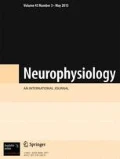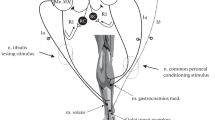Abstract
A study was made of changes in the amplitude of H-reflexes in m. gastrocnemius and the intensity of Ia inhibition in healthy subjects versus patients with midthoracic injury to the spinal cord before, during, and after voluntary tensing of the masticatory, cervical, and finger muscles. Tensing these muscles brought about facilitation of H-reflex and reduced intensity of Ia response in healthy subjects and patients with paraparesis but produced the opposite effect on paraplegics (or had no influence on reactions). This leads to a discussion of the relationship between the changes observed in reflex reactions and posttrauma damage to structure and function of the spinal cord.
Similar content being viewed by others
Literature Cited
M. E. Ioffe, Corticospinal Mechanisms Underlying Instrumental Motor Responses [in Russian], Nauka, Moscow (1975).
P. G. Kostyuk, Structure and Function of Spinal Cord Descending Systems [in Russian], Nauka, Leningrad (1973).
Ya. M. Kots, Organization of Volitional Movement [in Russian], Nauka, Moscow (1975).
R. S. Person, Spinal Mechanisms Underlying Control of Muscle Contraction [in Russian], Nauka, Moscow (1985).
A. I. Pilyavskii, I. A. Yakhnitsa, and N. V. Bulgakova, “Neuronal organization of ceruleo-spinal connections in the cat,” Neirofiziologiya,16, No. 3, 362–374 (1984).
A. I. Shapovalov, “Evolution of neuronal systems of suprasegmental motor control,” Neirofiziologiya,4, No. 5, 453–470 (1972).
V. C. Abrahams, “The physiology of neck muscles, their role in head movement and maintenance of posture,” J. Physiol. Pharmacol.,55, No. 1, 332–338 (1977).
T. Akaike, W. Fanardjian, M. Ito, et al., “Electrophysiological analysis of the vestibulospinal reflex pathway of rabbit. 1. Classification of tract cells,” Exp. Brain Res.,17, No. 2, 477–496 (1973).
A. R. Bright, “Cellular morphology of chronic spinal cord injury in the cat; analysis of myelinated axons by line-sampling,” Neuroscience,10, No. 2, 521–543 (1983).
B. Bussel, C. Morin, and E. Pierrot-Deseilligny, “Mechanisms of monosynaptic reflex reinforcement during Jendrassik manoeuvre in man,” J. Neurol. Neurosurg. Psychiatry,41, No. 1, 40–44 (1978).
J. F. M. Clough, C. G. Phillips, and J. D. Sheridan, “The short latency projection from the baboon's motor cortex to fusimotor neurons of the forearm and hand,” J. Physiol.,216, No. 1, 257–279 (1971).
M. Hugon, “Methodology of the Hoffmann reflex in man,” in: New Developments in Electromyography and Clinical Neurophysiology, Y. E. Desmedt (ed.), Vol 3, Karger, Basel (1973), pp. 277–293.
H. Hultborn, M. Illert, and M. Santini, “Convergence on interneurons mediating the reciprocal Ia inhibition on motoneurones. 3. Effects from supraspinal pathways,: Acta Physiol. Scand.,96, No. 2, 368–391 (1976).
H. Hultborn and J. Malmsten “Changes in segmental reflexes following chronic spinal cord hemisection in the cat. 1. Increased monosynaptic and polysynaptic ventral root discharges,” Acta Physiol. Scand.,119, No. 2, 405–422 (1983).
J. F. Iles and R. C. Roberts, “Presynaptic inhibition of monosynaptic reflexes from soleus muscle in spastic human subjects,” J. Physiol.,340, 29P (1983).
M. Ito, M. Udo, and N. Mano, “Long inhibitory and excitatory pathways converging onto cat reticular and Deiters neurons and their relevance to reticulofugal axons,” J. Neurophysiol.,33, No. 2, 210–226 (1970).
W. J. Little and E. M. Halar, “H-reflex changes following spinal cord injury,” Arch. Phys. Med. Rehabil.,66, No. 1, 19–22 (1985).
A. Lundberg, “Control, of spinal mechanisms from the brain,” in: The Nervous System, D. B. Tower (ed.), Raven Press, New York (1975), pp. 253–265.
Y. Mizuno, R. Tanaka, and N. Yanagisawa, “Reciprocal group I inhibition on triceps surae motoneurons in man,” J. Neurophysiol.,34, No. 6, 1010–1017 (1971).
D. D. Ralston and J. H. Ralston III, “The termination of corticospinal tract axons in the Macaque monkey,” J. Comp. Neurol.,242, No. 3, 325–337 (1985).
G. A. Robinson and M. E. Goldberger, “The development and recovery of motor function in spinal cats. 1. The infant lesion effect,” Exp. Brain Res.,62, No. 2, 373–386 (1986).
A. I. Shapovalov, G. G. Kurchavji, O. A. Karamjan, and Z. A. Repina, “Extrapyramidal pathways with monosynaptic effects upon primate motoneurons,” Experientia,27, No. 2, 522–524 (1971).
R. Tanaka, “Reciprocal la inhibition during voluntary movements in man,” Exp. Brain. Res.,21, No. 3, 529–540 (1974).
Additional information
A. A. Bogomolets Institute, of Physiology, Academy of Sciences of the Ukrainian SSR. Kiev. Translated from Neirofiziologiya, Vol. 20, No. 1, pp. 105–113, January–February, 1988.
Rights and permissions
About this article
Cite this article
Pilyavskii, A.I., Yakhnitsa, I.A., Potekhin, L.D. et al. Descending modulation of reflex reactions in spinal motoneurons produced by spinal cord injury in man. Neurophysiology 20, 85–91 (1988). https://doi.org/10.1007/BF02198431
Received:
Issue Date:
DOI: https://doi.org/10.1007/BF02198431



